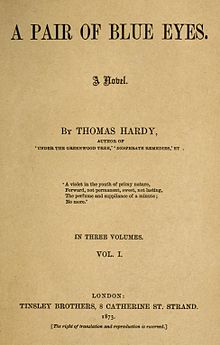
Sir John Falstaff is a fictional character who appears in three plays by William Shakespeare and is eulogised in a fourth. His significance as a fully developed character is primarily formed in the plays Henry IV, Part 1 and Part 2, where he is a companion to Prince Hal, the future King Henry V of England. Falstaff is also featured as the buffoonish suitor of two married women in The Merry Wives of Windsor. Though primarily a comic figure, he embodies a depth common to Shakespeare's major characters. A fat, vain, and boastful knight, he spends most of his time drinking at the Boar's Head Inn with petty criminals, living on stolen or borrowed money. Falstaff leads the apparently wayward Prince Hal into trouble, and is repudiated when Hal becomes king.
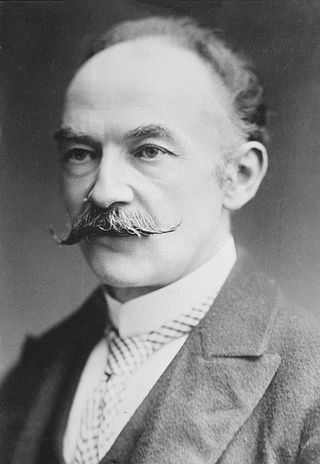
Thomas Hardy was an English novelist and poet. A Victorian realist in the tradition of George Eliot, he was influenced both in his novels and in his poetry by Romanticism, including the poetry of William Wordsworth. He was highly critical of much in Victorian society, especially on the declining status of rural people in Britain such as those from his native South West England.

A cliffhanger or cliffhanger ending is a plot device in fiction which features a main character in a precarious situation, facing a difficult dilemma or confronted with a shocking revelation at the end of an episode of serialized fiction or before a commercial break in a television programme. A cliffhanger is intended to incentivize the audience to return to see how the characters resolve the dilemma.

William Wilkie Collins was an English novelist and playwright known especially for The Woman in White (1859), a mystery novel and early sensation novel, and for The Moonstone (1868), which established many of the ground rules of the modern detective novel and is also perhaps the earliest clear example of the police procedural genre.

This article contains information about the literary events and publications of 1873.

The Mill on the Floss is a novel by English author George Eliot, pen name of Mary Ann Evans, first published in three volumes on 4 April 1860 by William Blackwood and Sons. The first American edition was published by Harper & Brothers, Publishers, New York.

Under the Greenwood Tree: A Rural Painting of the Dutch School is the second published novel by English author Thomas Hardy, published anonymously in 1872. It was Hardy's second published novel, and the first of what was to become his series of Wessex novels. Critics recognise it as an important precursor to his later tragic works, setting the scene for the Wessex that the author would return to again and again. Hardy himself called the story of the Mellstock Quire and its west-gallery musicians "a fairly true picture, at first hand, of the personages, ways, and customs which were common among such orchestral bodies in the villages of [the 1850s]".

The Hand of Ethelberta: A Comedy in Chapters is the fifth published novel by English author Thomas Hardy, published in 1876. It was written, in serial form, for The Cornhill Magazine, which was edited by Leslie Stephen, a friend and mentor of Hardy's. Unlike the majority of Hardy's fiction, the novel is a comedy, with both humour and a happy ending for the major characters and no suicides or tragic deaths. The late nineteenth century novelist George Gissing, who knew Hardy, considered it "surely old Hardy's poorest book".

The Woodlanders is the eleventh published novel by English author Thomas Hardy. The novel is set between 1856 and 1858. It was serialised from 15 May 1886 to 9 April 1887 in Macmillan's Magazine and published in three volumes in 1887. It is one of his series of Wessex novels.
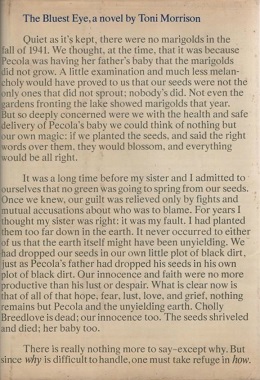
The Bluest Eye, published in 1970, is the first novel written by Toni Morrison. The novel takes place in Lorain, Ohio, and tells the story of a young African-American girl named Pecola who grew up following the Great Depression. Set in 1941, the story is about how she is consistently regarded as "ugly" due to her mannerisms and dark skin. As a result, she develops an inferiority complex, which fuels her desire for the blue eyes she equates with "whiteness".

"Childe Roland to the Dark Tower Came" is a narrative poem by English author Robert Browning, written on 2 January 1852, and first published in 1855 in the collection titled Men and Women. The poem is often noted for its dark and atmospheric imagery, inversion of classical tropes, and use of unreliable narration. Childe Roland, the only speaker in the poem, describes his journey towards "the Dark Tower", and his horror at what he sees on his quest. The poem ends when Roland finally reaches the tower, leaving his ultimate fate ambiguous.

Thomas Hardy's Wessex is the fictional literary landscape created by the English author Thomas Hardy as the setting for his major novels, located in the south and southwest of England. Hardy named the area "Wessex" after the medieval Anglo-Saxon kingdom that existed in this part of that country prior to the unification of England by Æthelstan. Although the places that appear in his novels actually exist, in many cases he gave the place a fictional name. For example, Hardy's home town of Dorchester is called Casterbridge in his books, notably in The Mayor of Casterbridge. In an 1895 preface to the 1874 novel Far from the Madding Crowd he described Wessex as "a merely realistic dream country".
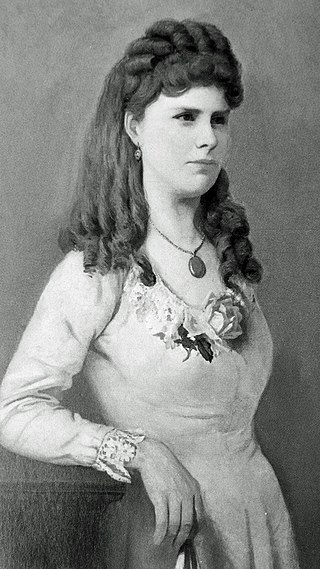
Emma Lavinia Gifford was an English writer and suffragist. She was also the first wife of the novelist and poet Thomas Hardy.

The Overlook is the 18th novel by American crime writer Michael Connelly, and the thirteenth featuring the Los Angeles detective Hieronymus "Harry" Bosch.
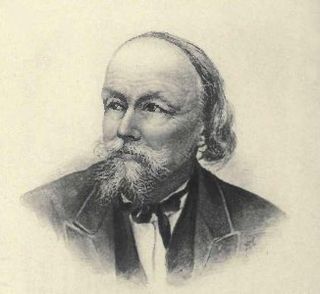
William Tinsley was a British publisher. The son of a gamekeeper, he had little formal education; but together with his brother Edward (1835–1865) he founded the firm of The Tinsley Brothers, which published many of the leading novelists of the time.

The Starlight Express is a children's play by Violet Pearn, based on the imaginative novel A Prisoner in Fairyland by Algernon Blackwood, with songs and incidental music written by the English composer Sir Edward Elgar in 1915.
Horatio Mosley Moule (1832–1873) was the fourth son of Anglican priest and inventor Henry Moule, and is best remembered as a friend of Thomas Hardy. He was generally known as Horace, to distinguish him from his Uncle Horatio, after whom he was named.
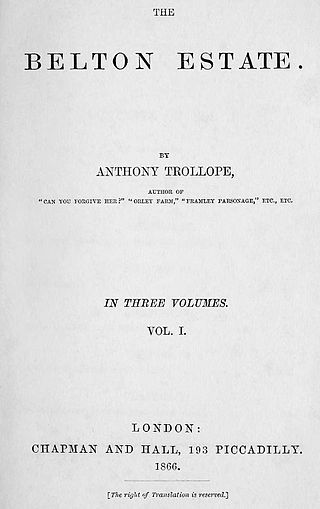
The Belton Estate is a novel by Anthony Trollope, published first in 1865. The novel concerns itself with a young woman who has accepted one of two suitors, then discovered that he was unworthy of her love. It was the first novel published in the Fortnightly Review.

The Vicar of Bullhampton is an 1870 novel by Anthony Trollope. It is made up of three intertwining subplots: the courtship of a young woman by two suitors; a feud between the titular broad church vicar and a low church nobleman, abetted by a Methodist minister; and the vicar's attempt to rehabilitate a young woman who has gone astray.

Annie Tinsley, born Annie Turner, was a British novelist and poet. She used the name Mrs Charles Tinsley.
